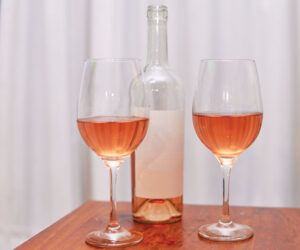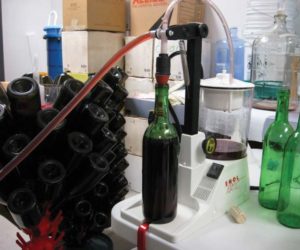
Q
I like ’em dry. Question? My last batch of Merlot (2001) came out too sweet. What can I do now if I want the finished wine to have less sweetness?
R.J. Yalch
Poland, OH
A
More experienced winemakers than yourself have spent eons trying to ponder the conundrum of a stuck fermentation. If you wanted the wine to be dry and it ended up sweet, it means that your yeast beasties, for whatever reason, could not ferment the sugar in their environment completely to alcohol. Here are some potential causes of a stuck or sluggish fermentation and some ideas on preventing them:
Problem: Initial Brix of juice too high.
Solution: Pick grapes less ripe, water down must or juice.
Problem: Yeast bred to ferment in a lower sugar concentration.
Solution: Choose the right yeast for the Brix level. Scott Labs in California (www.scottlab.com) is a good place to start. The company’s Website has lots of great information on fermentation and various yeast strains. You can also read the literature provided by leading suppliers of home wine yeast, such as White Labs, Wyeast, Red Star, Lallemand and the like. All of these companies offer detailed information about the yeast strains they sell and the Brix levels each strain can handle. Finally, WineMaker published an article about selecting the proper yeast strain — including a handy chart — in the Fall 2000 issue.
Problem: Yeast did not have adequate nutrition.
Solution: Feed them your favorite yeast nutrient blend; many home winemaking supply stores sell these. My favorite brand names are Superfood and Fermaid K. I mix these two in a 50-50 ratio and add in the neighborhood of 1 pound to 1,000 gallons, or about 3 grams to 5 gallons.
Problem: Yeast died due to high fermentation temperature.
Solution: Do not let fermentation temperatures rise above 95° F (35° C) at any point. If the yeast seem to be sticking between 1 to 0.5° Brix, do not let the temperature get above 80° F (27° C), as yeast’s cell membranes are more sensitive to alcohol permeation (alcohol toxicity) above 80° F.
Problem: Yeast died due to cold fermentation temperatures.
Solution: Make sure fermentation temperatures don’t drop below 55° F (13° C) at any point and that at the end of the fermentation, when the yeast are at their weakest, temperatures stay between 70 to 80° F (21 to 27° C). If possible, warm the tank at the end of the fermentation to reach 80° F (but do not go over that).
Problem: Your yeast were inhibited by sulfur dioxide.
Solution: Make sure you’re not using inordinately high levels of sulfur dioxide in the must stage and buy commercial Saccharomyces cereviseae yeast that are bred to withstand sulfur dioxide. (In other words, don’t even think about using naturally-present yeast to attempt a “wild” or “feral” fermentation.) For a complete rundown on monitoring and adjusting sulfur dioxide levels in your wine, see “Solving the Sulfite Puzzle” in the Winter 2000 issue of WineMaker.
In the meantime, you need to re-start fermentation in your sweet batch of Merlot. There are many ways to do this — enough to merit a feature article, in fact — but for the down-and-dirty solution, I’d suggest taking a small volume of your off-dry wine and adding a strong yeast, such as Lalvin’s EC-1118, along with some yeast nutrient. Ferment at a warm temperature. When fermentation starts, progressively double the volume of the batch until the entire carboy is fermenting again. This will work if the grapes were harvested at a normal Brix level. If the Brix was too high, you’re out of luck.
Q
I have some kind of grapes growing in my backyard, but have no clue as to what kind they might be. Is there a way to figure it out? Can you recommend some books?
John Schmidt
via email
A
The ancient science of identifying grapevines by their physical characteristics is called ampelography and, you’ll be happy to know, it is a relatively well-documented field. As you can imagine, in the days before genetic fingerprinting and DNA analysis technology, it was pretty valuable to be able to identify a grapevine by its size, shape, color and other visual characteristics.
There are many fine books that can get you started. The premier volume is “A Practical Ampelography: Grapevine Identification” by Pierre Galet, translated from French into English by Lucie T. Morton. This tome is recommended by many educational institutions and is often cited by winegrape industry professionals and educators alike. Luckily, it’s easy and clear enough for an amateur to use and has many color plates and drawings to aid in the identification process. This handy book is available online through www.amazon.com or through the California University at Fresno and the University of California at Davis bookstores. Other books to check out:
- “Rootstocks for Grape Vines” by D.P. Pongracz. This text is focused on rootstock but has a solid section on ampelography.
- “Viticulture” by Bryan Coombe and Peter Dry. This often called the “definitive text on Australian viticulture” and it’s worth buying, even if it is geared towards those who grow grapes south of the equator (I know many a viticulture newbie who got confused by the “reversal” of the months with regards to their antipodeal seasons). This two-volume set covers it all — ampelography is only a small, but detailed, part of the offering. The authors explain planting material, soil climate, taxonomy, phenology, varieties, aspects of operating a vineyard, trellising, management and more. It’s a great resource to have on hand.
If you want immediate gratification (and don’t want to wait for that Amazon shipment), try jumping onto http://www.dainet.de/eccdb/vitis/. This techno-heavy Website is sort of hard to navigate, but it nonetheless can show you a picture of Marechal Foch or Ugni Blanc. It’s the site of “An Information Service for the German Centre for Documentation and Information in Agriculture.” Good stuff. Who knew? Another terrific Website is found at www.grapeseek.com. Click on “Grape Pictures” for up-close-and-personal shots of hundreds of grape varietals, from Afus Ali to Zenit. Who knows? You might stumble across an exact photographic match.
For more of the Wizard’s wisdom, pick up a copy of the latest issue of WineMaker magazine, now available at better home winemaking supply shops and newsstand locations.







